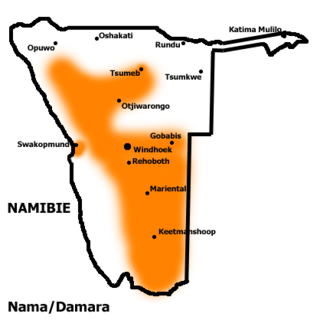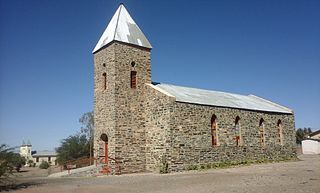
Khoekhoe are the traditionally nomadic pastoralist indigenous population of South Africa. They are often grouped with the hunter-gatherer San peoples. The designation "Khoekhoe" is actually a kare or praise address, not an ethnic endonym, but it has been used in the literature as an ethnic term for Khoe-speaking peoples of Southern Africa, particularly pastoralist groups, such as the Griqua, Gona, Nama, Khoemana and Damara nations. The Khoekhoe were once known as Hottentots, a term now considered offensive.

Khoekhoe, also known by the ethnic terms Nama, Damara (ǂNūkhoegowab), or Nama/Damara and formerly as Hottentot, is the most widespread of the non-Bantu languages of Southern Africa that make heavy use of click consonants and therefore were formerly classified as Khoisan, a grouping now recognized as obsolete. It belongs to the Khoe language family, and is spoken in Namibia, Botswana, and South Africa primarily by three ethnic groups: Namakhoen, ǂNūkhoen, and Haiǁomkhoen.

The ǁKharas Region is the southernmost, largest, and least densely populated of the 14 regions of Namibia; its capital is Keetmanshoop. The name assigned to the region reflects the prominence of the Karas mountain range in its southern part. The ǁKharas region contains the municipality of Keetmanshoop, the towns Karasburg, Lüderitz and Oranjemund, and the self-governed villages Aroab, Berseba, Bethanie, Koës and Tses.

Keetmanshoop is a town in the ǁKaras Region of southern Namibia. It is named after Johann Keetman, a German industrialist and benefactor of the city. Keetmanshoop had a population of 27,862 people in 2023.

The Damara, plural Damaran are an ethnic group who make up 8.5% of Namibia's population. They speak the Khoekhoe language and the majority live in the northwestern regions of Namibia, however, they are also found widely across the rest of the country.

Nama are an African ethnic group of South Africa, Namibia and Botswana. They traditionally speak the Nama language of the Khoe-Kwadi language family, although many Nama also speak Afrikaans. The Nama People are the largest group of the Khoikhoi people, most of whom have disappeared as a group, except for the Namas. Many of the Nama clans live in Central Namibia and the other smaller groups live in Namaqualand, which today straddles the Namibian border with South Africa.

Hendrik Witbooi was a chief of the ǀKhowesin people, a sub-tribe of the Khoikhoi. He led the Nama people during their revolts against the German colonial empire in present-day Namibia, in connection with the events surrounding the Herero and Namaqua Genocide. He was killed in action on 29 October 1905. Witbooi is regarded as one of the national heroes of Namibia, and his face is portrayed on the obverse of all N$50, N$100, and N$200 Namibian dollar banknotes.

Berseba is a village in the ǁKaras Region of southern Namibia. It is situated near the Brukkaros Mountain, a famous tourist destination. Berseba had 992 inhabitants in 2023.

Bethanie is a village in the ǁKaras Region of southern Namibia. It is one of the oldest settlements in the country. Bethanie had 2,372 inhabitants in 2023.

The Oorlam or Orlam people are a subtribe of the Nama people, largely assimilated after their migration from the Cape Colony to Namaqualand and Damaraland.

Warmbad is a settlement located in the ǁKaras Region of southern Namibia. It is situated south of Karasburg at the Homs River, close to the border with South Africa, and belongs to the Karasburg electoral constituency.

Aus is a settlement in the ǁKaras Region of southern Namibia. It lies on a railway line and the B4 national road, 230 km west of Keetmanshoop and about 125 km east of Lüderitz and belongs to the ǃNamiǂNûs electoral constituency. Trains from Keetmanshoop now end their journey at the village but formerly continued on to Lüderitz. The settlement is small but has a number of amenities including a hotel, police station, shop and garage. It is located in the Aus Mountains above the plains of the Namib Desert. The climate is usually hot and arid but snow has been recorded in the winter of 1963, and the area features the coldest winters recorded in Namibia.
Jager Afrikaner was the third Captain of the Orlam people in South West Africa, succeeding his father Klaas Afrikaner at around 1800. Before converting to Christianity through the missionary efforts of Robert Moffat, Afrikaner and his followers were considered notorious bandits. He was one of the founders of Namibia's first systematic settlement in an engineering sense, ǁKhauxaǃnas. After his death in 1823 his son Jonker Afrikaner succeeded him as Captain of the Afrikaner Orlams.

ǁKhauxaǃnas is an uninhabited village with a ruined fortress in south-eastern Namibia, east of the Great Karas Mountains. It is the oldest systematically designed and built structure in Namibia, pre-dating all buildings erected by Europeans. Built at the end of the 18th century, most likely between 1796 and 1798 by Klaas Afrikaner and his two sons Jager and Titus, ǁKhauxaǃnas served as a hidden retreat and a fortress to fend off possible pursuits by Cape authorities. The Orlam Afrikaner tribe left the place in the 1820s but it continued to be inhabited by the Veldschoendragers (ǁHawoben) tribe until the mid-19th century.
Hoachanas is a settlement of 3,000 inhabitants in the Hardap Region of southern central Namibia, located 55 kilometres (34 mi) northeast of Kalkrand. It is situated at the junction of the main road C21 from Kalkrand, and C15 from Dordabis to Stampriet and belongs to the Mariental Rural electoral constituency.

Reverend Johann Heinrich Schmelen, born Johann Hinrich Schmelen was a German missionary and linguist who worked in South Africa and South-West Africa. Traveling through the area of today's northern South Africa and central and southern Namibia he founded the mission stations at Bethanie and Steinkopf and discovered the natural harbour at Walvis Bay. Together with his wife Zara he translated parts of the Bible into Khoekhoegowab (Damara/Nama) and published a dictionary.
The Red Nation is the main subtribe of the Nama people in Namibia and the oldest Nama group speaking Khoekhoegowab, the language often called Damara/Nama.
The origins of the surname "Visagie", is believed to originate from Flanders (Belgium) at the turn of the 17th century.
The ǀKhowesin are one of five clans of the Orlam people in Namibia. They originated from Pella in the Cape Colony in South Africa and migrated to South West Africa the 19th century, led by their Kaptein Kido Witbooi. They crossed Orange River and moved to the Fish River area living a nomadic existence. They eventually settled in what became known later as Gibeon.
Guilliam is a given name. Notable people with the name include:













